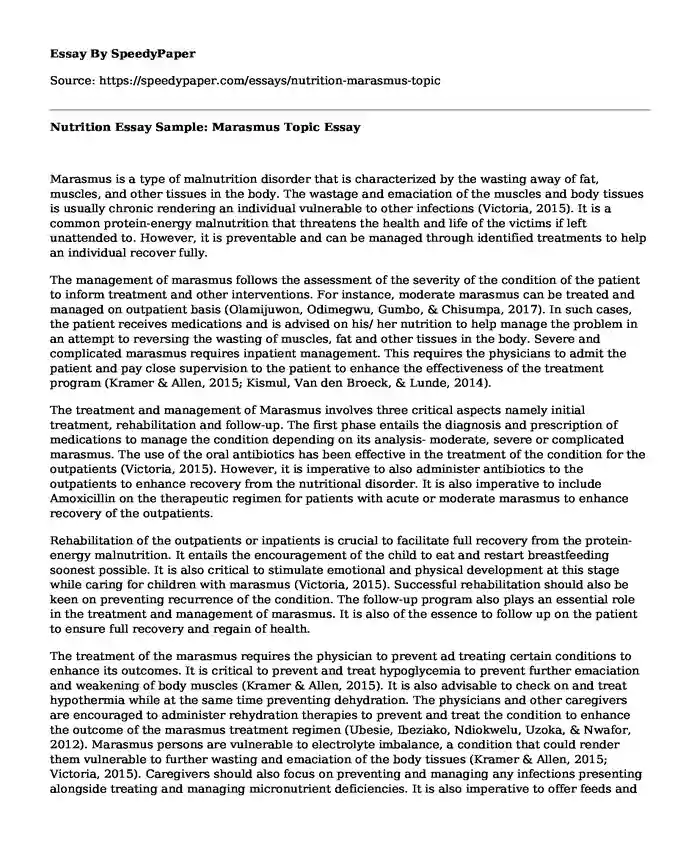Marasmus is a type of malnutrition disorder that is characterized by the wasting away of fat, muscles, and other tissues in the body. The wastage and emaciation of the muscles and body tissues is usually chronic rendering an individual vulnerable to other infections (Victoria, 2015). It is a common protein-energy malnutrition that threatens the health and life of the victims if left unattended to. However, it is preventable and can be managed through identified treatments to help an individual recover fully.
The management of marasmus follows the assessment of the severity of the condition of the patient to inform treatment and other interventions. For instance, moderate marasmus can be treated and managed on outpatient basis (Olamijuwon, Odimegwu, Gumbo, & Chisumpa, 2017). In such cases, the patient receives medications and is advised on his/ her nutrition to help manage the problem in an attempt to reversing the wasting of muscles, fat and other tissues in the body. Severe and complicated marasmus requires inpatient management. This requires the physicians to admit the patient and pay close supervision to the patient to enhance the effectiveness of the treatment program (Kramer & Allen, 2015; Kismul, Van den Broeck, & Lunde, 2014).
The treatment and management of Marasmus involves three critical aspects namely initial treatment, rehabilitation and follow-up. The first phase entails the diagnosis and prescription of medications to manage the condition depending on its analysis- moderate, severe or complicated marasmus. The use of the oral antibiotics has been effective in the treatment of the condition for the outpatients (Victoria, 2015). However, it is imperative to also administer antibiotics to the outpatients to enhance recovery from the nutritional disorder. It is also imperative to include Amoxicillin on the therapeutic regimen for patients with acute or moderate marasmus to enhance recovery of the outpatients.
Rehabilitation of the outpatients or inpatients is crucial to facilitate full recovery from the protein-energy malnutrition. It entails the encouragement of the child to eat and restart breastfeeding soonest possible. It is also critical to stimulate emotional and physical development at this stage while caring for children with marasmus (Victoria, 2015). Successful rehabilitation should also be keen on preventing recurrence of the condition. The follow-up program also plays an essential role in the treatment and management of marasmus. It is also of the essence to follow up on the patient to ensure full recovery and regain of health.
The treatment of the marasmus requires the physician to prevent ad treating certain conditions to enhance its outcomes. It is critical to prevent and treat hypoglycemia to prevent further emaciation and weakening of body muscles (Kramer & Allen, 2015). It is also advisable to check on and treat hypothermia while at the same time preventing dehydration. The physicians and other caregivers are encouraged to administer rehydration therapies to prevent and treat the condition to enhance the outcome of the marasmus treatment regimen (Ubesie, Ibeziako, Ndiokwelu, Uzoka, & Nwafor, 2012). Marasmus persons are vulnerable to electrolyte imbalance, a condition that could render them vulnerable to further wasting and emaciation of the body tissues (Kramer & Allen, 2015; Victoria, 2015). Caregivers should also focus on preventing and managing any infections presenting alongside treating and managing micronutrient deficiencies. It is also imperative to offer feeds and nutritional intervention for initial stabilization of the condition, catch-up growth, loving care and stimulation, and organize follow-ups after discharging the patients.
As illustrated in the discussion, marasmus is a preventable malnutrition disorder that adversely affects the children. Its management entails the initial treatment for the inpatient and outpatients, rehabilitation and making a follow-up to ascertain full recovery and prevent recurrence of the condition in the future. The disorder can be treated as inpatient or outpatient depending on the severity of the condition to enhance the outcome of the treatment regimen.
References
Kismul, H., Van den Broeck, J., & Lunde, T. M. (2014). Diet and kwashiorkor: a prospective study from rural DR Congo. PeerJ, 2, e350.
Kramer, C. V., & Allen, S. (2015). Malnutrition in developing countries. Paediatrics and child health, 25(9), 422-427.
Olamijuwon, E. O., Odimegwu, C. O., Gumbo, J., & Chisumpa, V. H. (2017). Single motherhood and marasmus among under-five children in Sub-Saharan Africa: a regional analysis of prevalence and correlates. African Population Studies, 31(1).
Ubesie, A. C., Ibeziako, N. S., Ndiokwelu, C. I., Uzoka, C. M., & Nwafor, C. A. (2012). Under-five protein energy malnutrition admitted at the university of in nigeria teaching hospital, enugu: A 10 year retrospective review. Nutrition Journal, 11, 43. http://dx.doi.org/10.1186/1475-2891-11-43.
Victoria, S. (2015). Protein Energy Deficiency Type Marasmus with Pulmonary Tuberculosis. Jurnal Agromedicine, 2(1), 47-51.
Cite this page
Nutrition Essay Sample: Marasmus Topic. (2022, Mar 24). Retrieved from https://speedypaper.net/essays/nutrition-marasmus-topic
Request Removal
If you are the original author of this essay and no longer wish to have it published on the SpeedyPaper website, please click below to request its removal:
- MBA Personal Statement, Free Example for Everyone
- Free Essay in History: Effects of Peace Settlement of 1919
- Free Essay: Exposure Routes and Health Effects of Heavy Metals on Children
- What Will My Footprint Mean to the World? Scholarship Essay Example
- Free Essay on Senior VP of HR - Job Outlook and Duties, Education and Training Requirements
- Essay Example on Situation Crisis Theory
- Affordable Care Act. Essay Example
Popular categories





